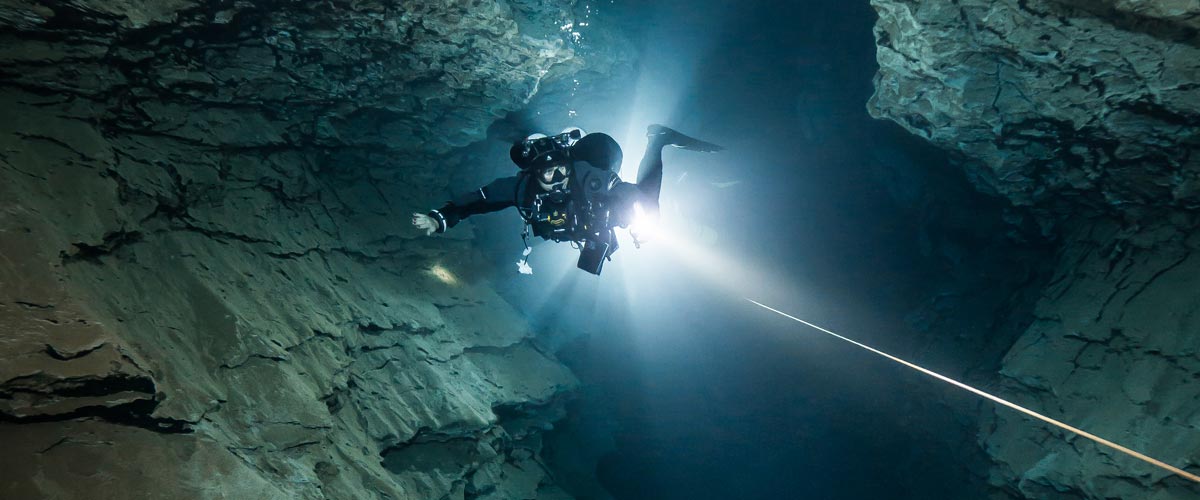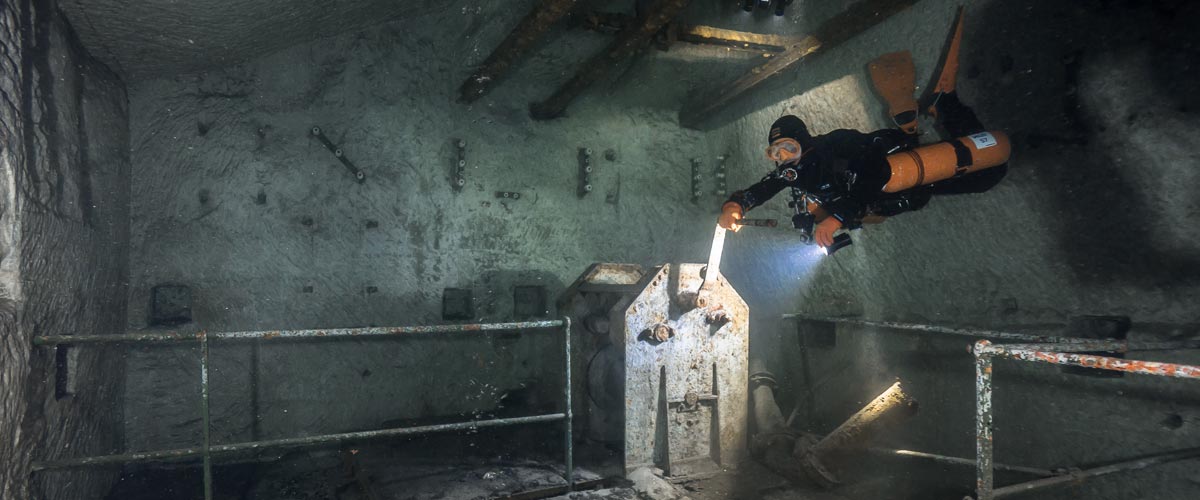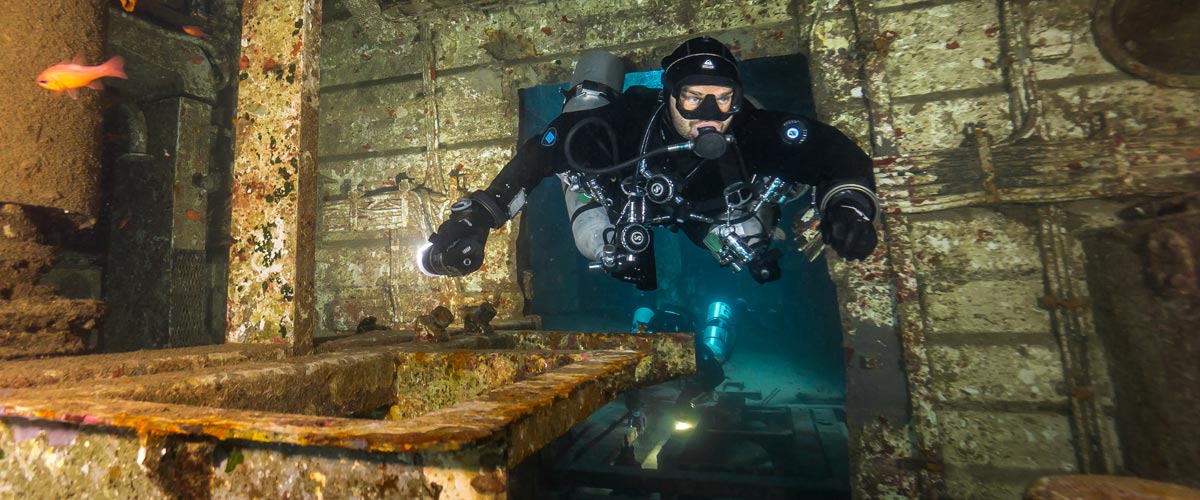Dive Training Blogs
Deptherapy returns to its Roots – Part 4
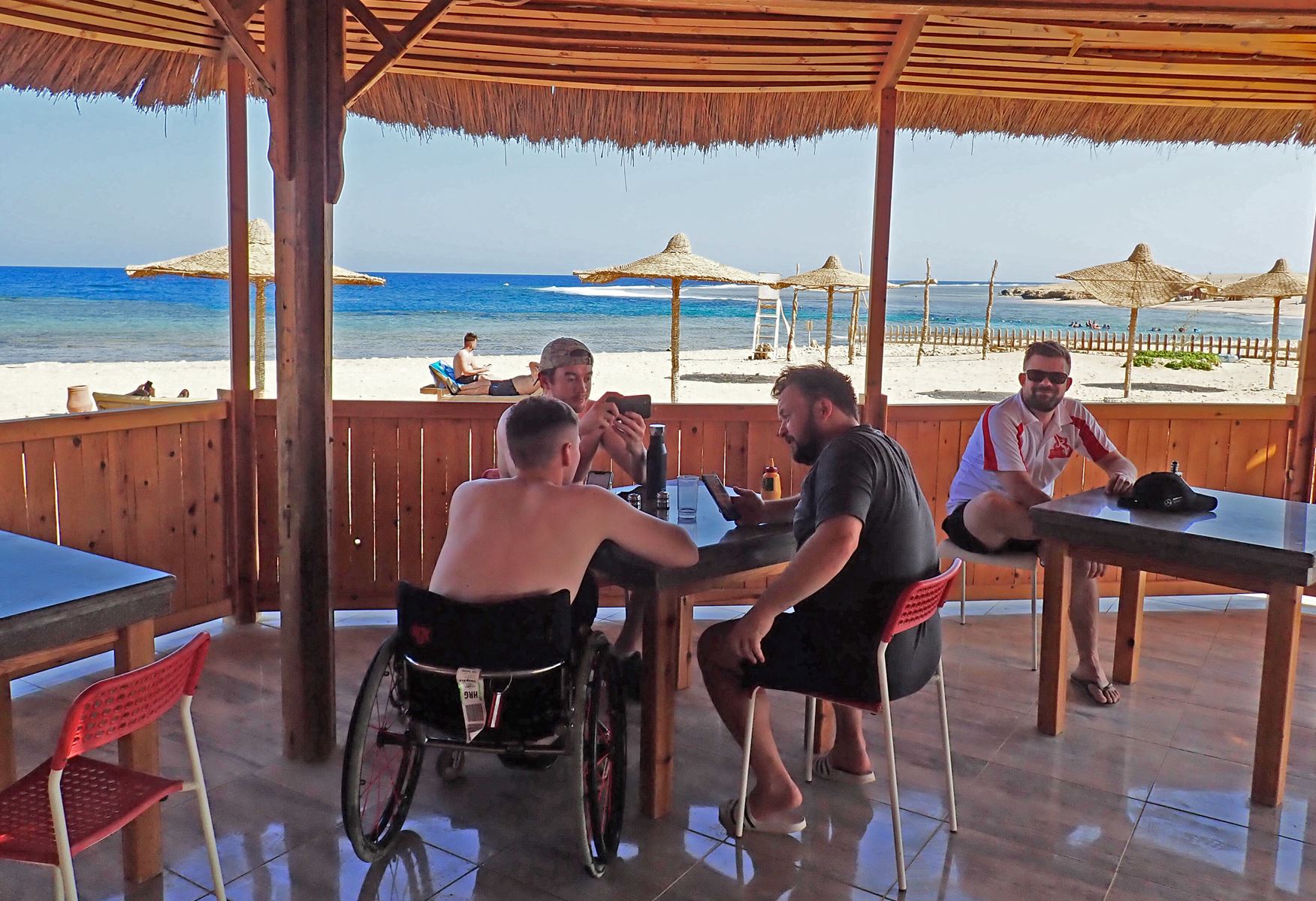
Join Richard Cullen from Deptherapy for part 4 of his Blog about the charity’s recent expedition to Roots Red Sea, El Quseir, Egypt.
We are all back to the house reef today; the weather is lovely, the sea calm, the tide will soon be slack, so a great day’s diving in store.
A few yards away from the beach dive centre, on the Roots’ beach is their day time restaurant. It is where we take lunch when diving, and there is a continual supply of tea, coffee and soft drinks, and some marvellous lunches. There are also male and female toilets and a fully accessible toilet for those using wheelchairs.
A few thoughts around working with amputees and those who have paraplegia. Firstly amputees – the part of the limb remaining is known as the ‘stump’, and we have worked with a substantial number of bilateral leg amputees (both legs), single leg amputees and single arm amputees. The level of amputation can be above or below the knee or elbow, or through the knee. In one case the amputation was transpelvic and in another through the shoulder. Some like Chris Middleton have one leg amputated above the knee and one below the knee. This is rare, but each type of amputation offers a different challenge.
Many people think the amputation is clean and the skin neatly tidied up after surgery. Although that occurs in a few cases, in most the stump is rather rugged. Elasticity of the skin around the stump is often exceptionally poor and can easily be damaged. Some of our beneficiaries, as they were injured as young men, suffered from heterotopic ossification – this is where the bone tries to grow after amputation and often penetrates the skin, resulting in further surgery being required to cut back the bone and of course the stump needs to be restitched. Very often stumps are sealed with skin from elsewhere on the body.
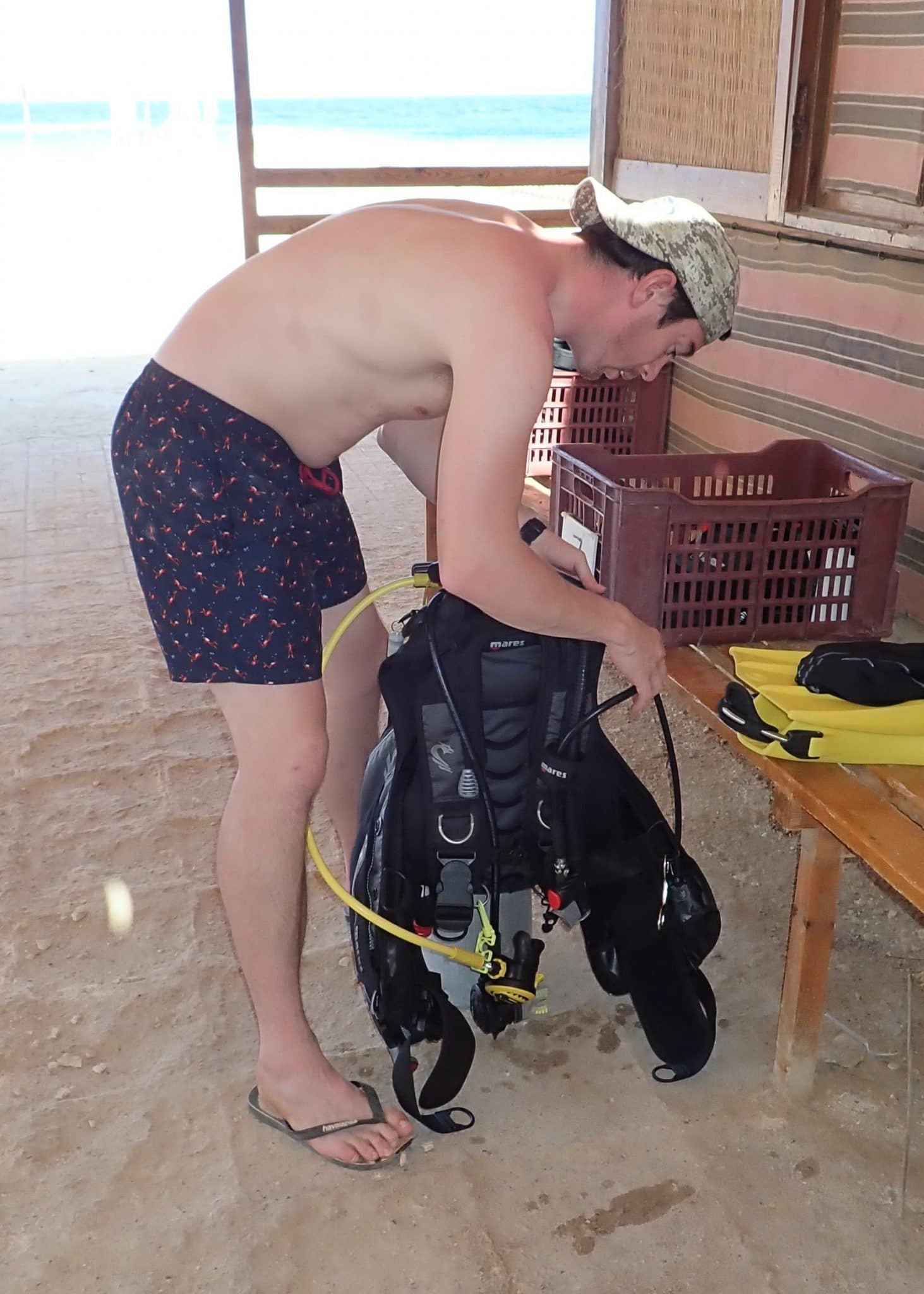
Swars kitting up
Few divers have never experienced a graze or cut underwater but such an experience for those with amputations can have serious consequences. Stumps are more likely to get cut or grazed as the skin is so tight. We all know that there are lots of infections in seawater and if infected the cut or graze can cause very serious problems for the amputee. Tailored wetsuits are one preventative measure, as are daily stump checks, making sure there is no damage and if there is, applying medication and or protecting the stump.
Those with paraplegia provide an additional challenge, not being able to feel their lower limbs they can easily damage them, so cuts, abrasions, and even sunburn can go unnoticed. Donning a full-length wetsuit can be a challenge as toes can easily be broken and hairs pulled out of legs. On the Deptherapy Education Professionals’ Course we show how to fit a wetsuit properly.
In recent discussions between our dive medicine advisor Mark Downs and our VP Richard Castle, who is a consultant psychologist, we have been looking at areas for further medical research in terms of diving for those with disabilities. One area of suggested study is thermoregulation. The theory is that those with amputations and those with paraplegia suffer more with the cold as their body is unable to regulate heat. Certainly, in Corey’s case, he feels the cold more quickly than those diving with him. Chris Middleton can feel the cold more quickly than others with amputations but that may well be that Chris is muscle and bone where, to put it nicely, others have a more substantial covering.
Some AMEDs and Dive Referees will not sign off amputees as being fit to dive. That is their professional opinion and although we can show that even triple amputees are more than capable divers, capable of progressing to Rescue Diver standard even, they still refuse to sign them off. Last year Oli and Mark invited us to speak at the UK Annual Hyperbaric Medicine Conference in London where Josh Boggi, the world’s first triple amputee Rescue Diver and a Deptherapy beneficiary spoke about how amputees can become safe and successful divers.
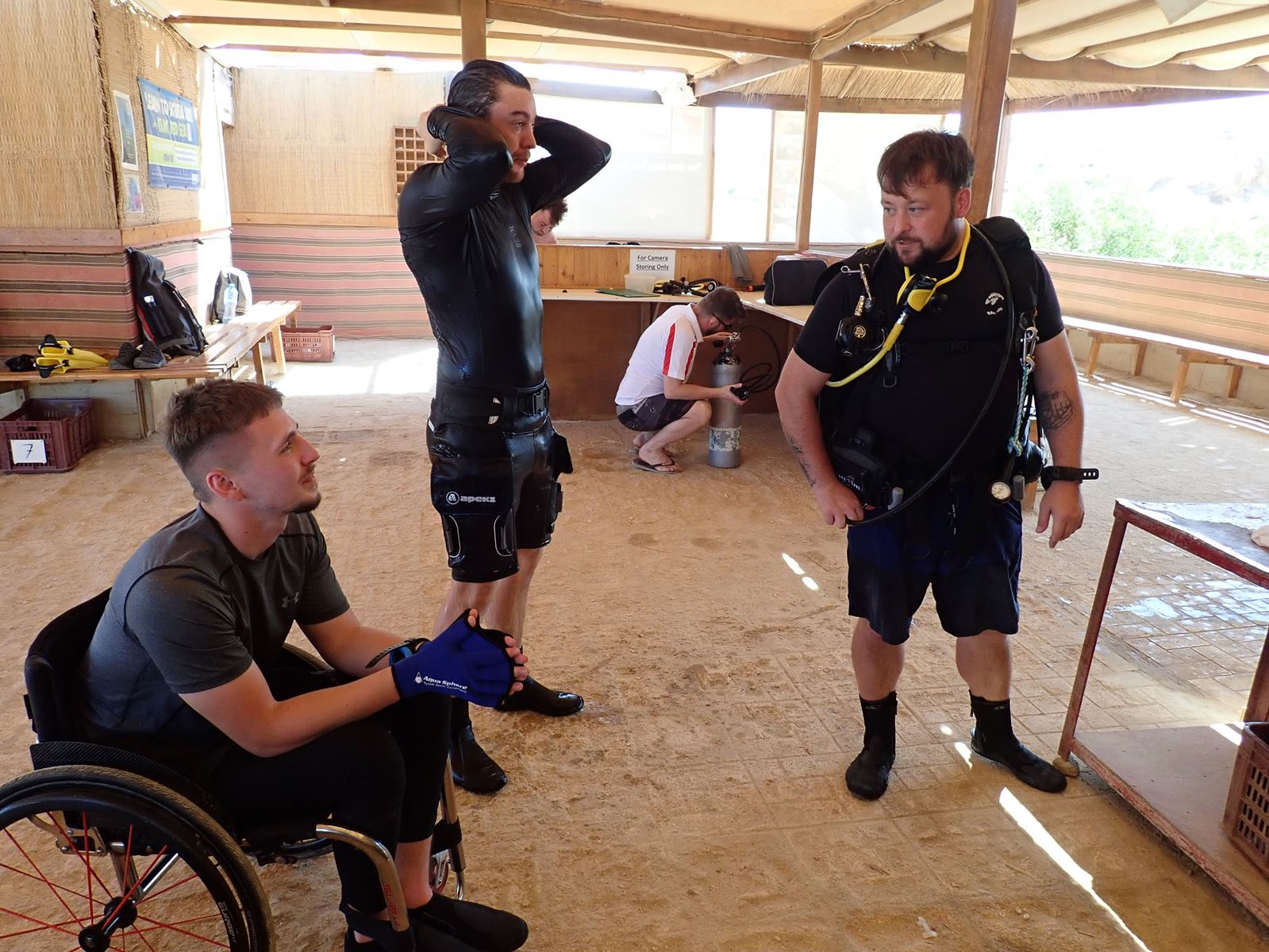
Corey, Swars and Michael
For Corey, he wears full leg coverings and diving boots in the water; as he cannot use his legs there is no purpose in wearing fins.
Another point around amputations is that most of the general population make an assumption that a leg amputation is the result of a traumatic incident. That is incorrect; by far the majority of leg amputations in the UK are the result of diabetes. Those whose legs are amputated as a result as diabetes are more likely to have poor healing of the stumps. This also presents an issue of comorbidity that may well result in an AMED or Dive Referee declining to sign them off as ‘fit to dive’. If signed off you would need to be very aware of the health of a stump; I certainly would not take someone with an open wound diving and the fact that they will be on medication for the diabetes. You also have to be aware that they may well be on other medication to manage pain etc.
You need to be very clear with those who have paraplegia and other conditions that they must let you know if they start to feel cold.
Managing air – diving just using your arms for propulsion can, for many, be very tiring and a considerable amount of effort is required. This, plus other factors, may result in enhanced air consumption by the diver. This may increase if a current is encountered, even one which most divers who have use of their legs and dive with fins would not cause the least concern.
Within Deptherapy we very much work on the ‘rule of thirds’ – a third of your air to get you down and to see what you want to see, a third to get you back to the surface and a third in reserve. This in most circumstances will ensure no ‘low on air’ or ‘out of air’ situations.
Say if we have 210 bar in a cylinder that means 70 bar out, so turn on 140 bar, 70 bar to return and to the surface so we should have 70 bar reserve at the surface.
We also work our students through SAC rates and looking at the air consumption of others in their team.
Checking the team’s air frequently during a dive is stressed to all our Pro team.
Keiron became very engaged with this concept as the result of the online RAID study for his Master Rescue Diver.
On expeditions we normally dive in small teams, a DM/TDM with three programme members. They work as a team and understand each other’s air consumption. Of course, they also dive as buddy pairs.
Today offered perfect conditions for diving, and Keiron, Moudi, and this time TDM Oatsie were kitted up and in the water within minutes.
Pause for thought… those with paraplegia will have different toileting arrangements to those who do not have the condition. This also applies to some who have suffered traumatic limb loss. They may use catheters for urination, some may have Stoma bags etc. This all has to be planned into your dive schedule to ensure the safety and comfort of your student. For young people talking about these very personal arrangements may be very difficult. Those with Stoma bags may be embarrassed by people seeing them. This is another part of seeing beyond the injury or condition – it is the person inside that you are dealing with.
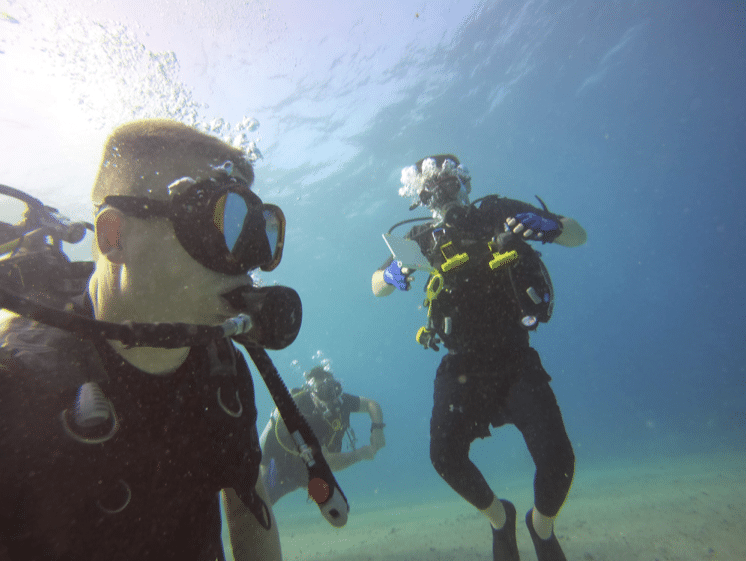
Corey on the Roots House Reef
So, Corey, Michael and myself were joined by Swars. Swars, although he joined the DM programme at the same time as the other guys, because of work commitments was unable to join us in September 2019 at Roots where we ran a DM introductory programme alongside the crossover of our Pro Team to RAID. Swars has become a really good mate; he is a great diver, with an engaging personality.
Michael and Oatsie were a known quantity to me as they had been on the September 2019 programme and both have travelled to my home dive centre Divecrew in Crowthorne, Berkshire, to work on courses, pre-COVID. During COVID Michael and I, plus a few of the guys from Divecrew, have dived at Wraysbury together.
Just as Roots is our base in Egypt, Divecrew is our base in the UK, and through this relationship, Martin (who owns Divecrew with his wife Sue) is one of our trustees. Together they have established a centre where pretty much 100% of the Pros are Deptherapy Education trained.
I asked Swars straight away to brief a dive for Corey. I gave him the briefing slate, a few tips and then ten minutes later he came back with a perfect briefing… and I mean perfect. So, a great briefing under his belt; now to watch him work with Corey in open water. He looked the Pro, he knew what he should be doing, he understood his role. We assigned Michael as Corey’s buddy and said he would lead the dive. I was there to assess the TDMs and supervise very closely Corey’s skill demonstrations.
Again, it comes as no surprise that many beneficiaries in Deptherapy can move straight into dive management, as several were NCOs, as was Swars, and they are used to briefing individuals and teams.
We had decided that we would mix up the dives required to complete Corey’s OW 20 RAID dives with some general diving as trim and swimming arm action are all important. We also needed to concentrate on spatial awareness.
We agreed a signal for horizontal trim and Swars reinforced the swim stroke that Corey needed to do to get propulsion. Every time Corey moved out of horizontal trim Swars was there reminding him about trim and reminding him of his swim stroke.
The Roots’ House Reef is amazing – at a metre you encounter a shoal of black Damselfish, at 3 metres a shoal of Unicornfish, there are Butterflyfish and all manner of other fishes in great profusion. The coral is in great condition. It really is a place of beauty and tranquillity.
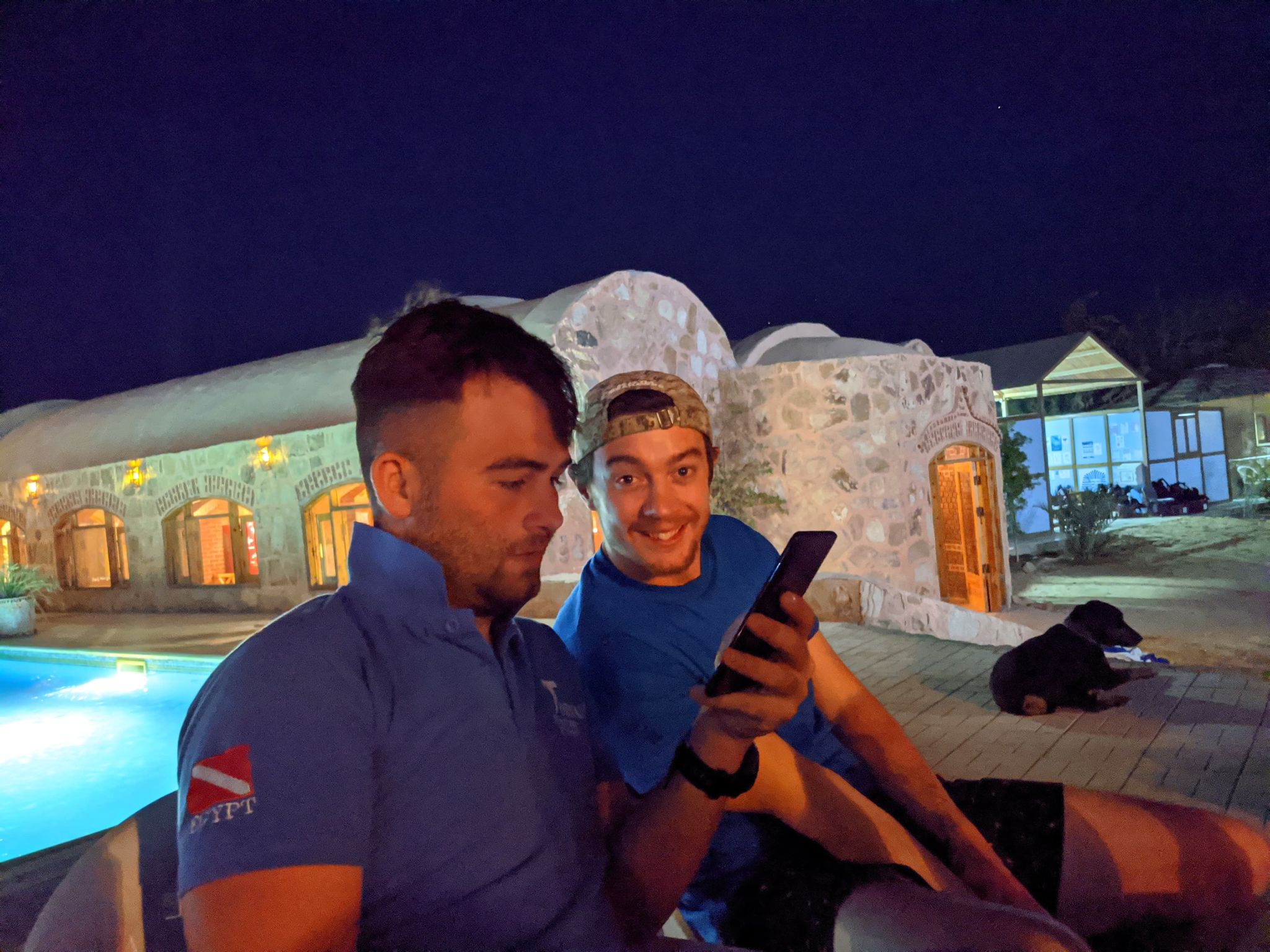
Oatsie and Swars relaxing by the Roots pool after a long day
Although we had problems getting Corey underwater again, once we got him in skill demonstration mode his anxieties disappeared. We then took him diving. Steve Rattle, the owner of Roots joined us and was taking photos that provide a great record of the week’s diving. Steve commented on the quality of Swars and Michael’s supervision and control underwater of Corey and gave them feedback on how impressed he was.
Meanwhile on the RAID Master Rescue Course, Oatsie who was in the same Regiment, same Platoon and Section as Keiron in Afghanistan was more than willing to be a very uncooperative victim for his brother-in-arms. I think Keiron gave Oatsie some feedback about this!
For me this was a hard week, combining running the RAID OW 20 for Corey but also the assessment of our three TDMs. A week underwater but no opportunity to dive for myself. People often think Deptherapy Expeditions are holidays for the Dive Team; they are not, it is hard work and I mean hard work.
Tomorrow is Day 4 in the water Day 5 of our trip. We are on the House Reef again, and things are starting to come together. Join us back here on Monday 26th October…
Find out more about the work of Deptherapy and Deptherapy Education at www.deptherapy.co.uk
Blogs
Intro to Tech: What is it about?
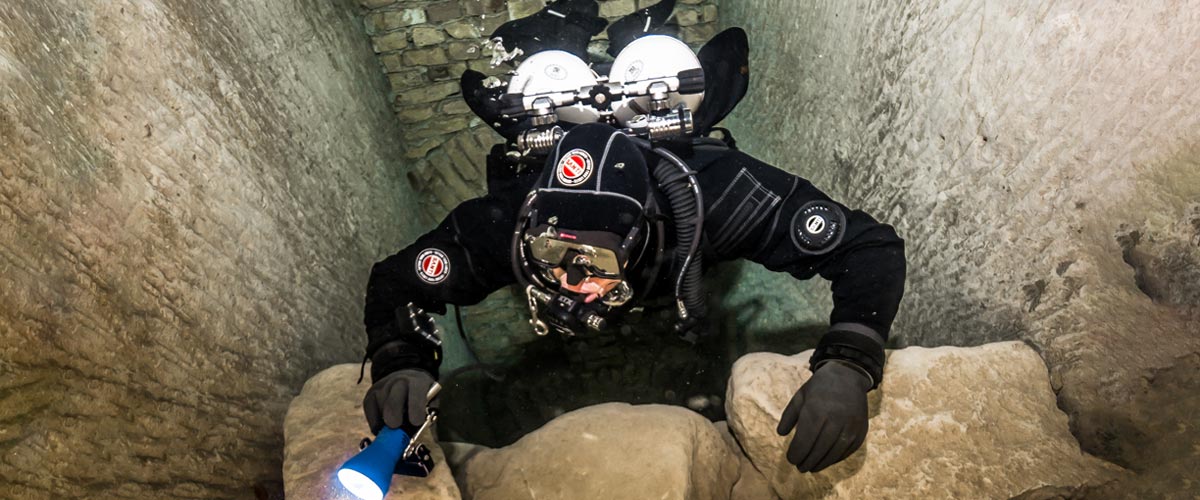
Article by José Pablo Mir
Pictures by Cezary Abramowski
The world of technical diving is exciting. It opens the door to new sites, depths, and bottom times. More importantly, it opens our minds to a new way of planning, facing, and experiencing dives, even those not purely technical.
Becoming a technical diver is a process, and like in other aspects of life, we should find the proper entry point that suits us best based on our knowledge and experience. The Introduction to Technical Diving course from TDI -the world’s largest and most recognized technical diving teaching organization- is the best option for divers who have yet to gain experience in the fundamental aspects of this new practice. The course’s content and its embrace of new techniques and technologies make it possible to acquire a solid foundation to learn and gain experience in this practice properly.
Becoming a technical diver is not something that happens overnight, whether deciding to become one or receiving a certification card stating we are now technical divers. It is a slow process extending farther away than any introductory course. It requires effort and dedication. But it will bring us satisfaction from day one -or two.
It is a matter of mentality
First, we must understand and accept that technical diving, involving greater depths, longer bottom times, exotic gases, virtual or real ceilings, and more, comes with higher levels of risk than the sport diving we have been practicing until now.
Although this discussion usually starts with a warning about risks, as I’ve done in the previous sentence, our practice is not a game of chance.
Technical diving is a rational activity that requires maturity and good judgment, and we will put everything into ensuring that each dive is a successful one -meaning we return from it safe and sound. With this understanding, we will strive to establish a mental attitude more aligned with our practice and its realities.
This new “technical diver” mindset we will develop will lead us to be more cautious in our executions, more analytical in our plans, more rational in our strategies, and more detailed in our procedures.
Experience will keep teaching us to know ourselves better, to keep our anxiety and other emotions under control, and to manage our impulses. Over time, our senses will sharpen, and we will be more attentive to the particulars of the situation we find ourselves in.
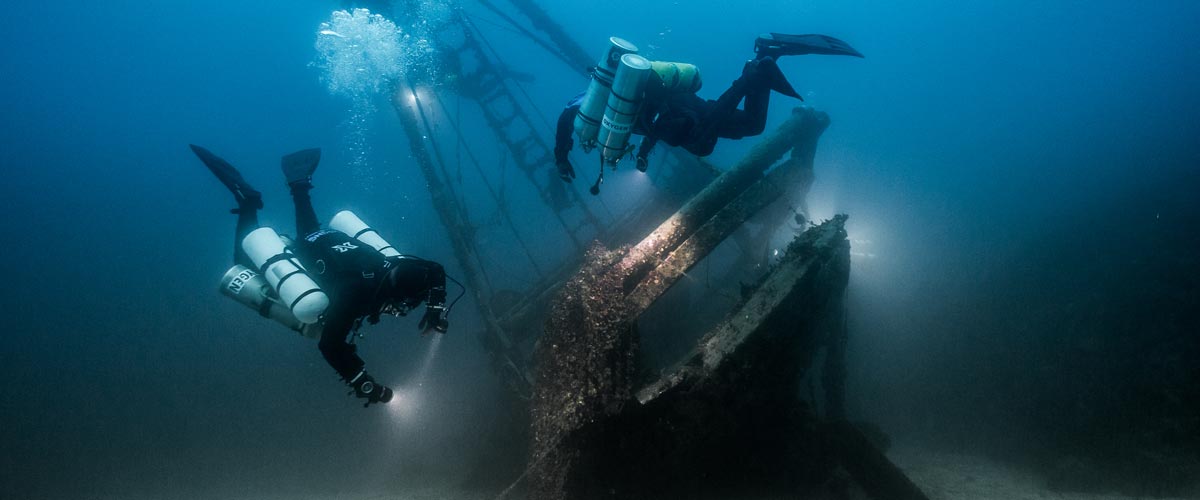
Strategies and procedures
Our strategies, those broad guiding lines tracing the path to follow, from how to approach planning to where, with what, and how we are willing to get there, will be more specific and more practical. Not because they magically become so, but because we will consciously and deliberately frame them that way.
We will establish clear, concise, and realistic procedures. Not only for the undesirable situations that may present themselves but also for those that are part of our dive objectives.
Even though, as technical divers, we often use equipment different from what we were previously accustomed to, it is essential to note that the gear does not make the diver. In a way, we could consider such equipment as the necessary tools to implement what our goal seeks to achieve, according to our strategies and procedures.
Technique plays an important role
We must put our greatest effort into learning and perfecting the different techniques we will be acquiring. Buoyancy, trim, propulsion, cylinder handling, deploying DSMBs and lift bags, valve drills, and more are essential skills we must begin to master to progress in our art. What we cannot do, when we need to do it, can harm us.
Our techniques must be effective and achieve the purpose for which they were devised. But they must also be efficient and require the least resources possible, including the time they take and the effort they demand. Effectiveness and efficiency will prevail over beauty and other considerations that may come to mind, although none of them should be mutually exclusive. A technique executed efficiently and effectively tends to have an inherent beauty.
Refining techniques is a lifelong mission. Some of them will be easy to master from the go; others, on the other hand, will be our life mission and will require many repetitions just to resemble the idea we have in mind of how they should be executed.
We must consider the environment
Our learning, the needs and musts of the practice we engage in, the experience we gradually gain, our strategies and procedures, and even our equipment and tools change with the environment.
Diving in the ocean, everything about us must be suitable for ocean dives. Conditions there rarely emulate those found in a pool, lake, or river. Variable winds and currents, greater depths, visibility conditions, other divers with uncertain skills around us, marine life, maritime traffic, distance from the coast, and many other factors add complexity and uncertainty.
It is never necessary to master the pool on the first day, but planning and aspiring to gradually cope with the ocean’s conditions is essential.
The cost of good training
We are aware that our resources are often scarce in relation to the possibilities of use we could give them if they were not. To a greater or lesser extent, we are part of the economic reality in which we are embedded.
Fortunately, the cost of good technical diver training is not an entry barrier. Comparing training and equipment costs, we see that the former are generally lower. Yes, lower cost for personalized service, essential to our future
performance and safety, than for a series of mass-produced products that are mere, albeit necessary, tools for an end.
The value of good training
The value of the training we received encompasses a range of characteristics, from emotional and methodological to technical and technological. TDI and its Introduction to Technical Diving course offer a deep and modern approach, with a teaching strategy that aims to create thinking divers, not merely obedient ones.
As technical divers, our knowledge is our primary tool. In this type of activity, what we don’t know can harm us.
Is this course optional?
Unfortunately, the fact that this Introduction to Technical Diving course is not a prerequisite for any subsequent training is an invitation to consider it optional. And we all know what usually happens to “optional” under budget constraints.
However, this course should be seen as optional only by those divers who are somehow familiar with the use of technical equipment, who have a mindset more in line with the requirements of this type of diving, who plan and execute the dives the proper “technical” way, who know their gas consumption rate, who are not intimidated by non-decompression tables, who feel comfortable using their dive computers, and know the techniques and have at least an acceptable level of buoyancy, positioning, and propulsion. Those can go straight to a more advanced training course, such as TDI’s Advanced Nitrox.
We must ask ourselves whether or not we are in that group.
Remember our goal: to have fun
Recreational diving is our passion. Jumping into the water carrying heavy equipment and having properly dotted our I’s and crossed our T’s have only one ultimate goal: fun. This is the activity we have chosen as a hobby. We must enjoy it; it must give us pleasure and make us vibrate.
Having a good time is not optional!
Blogs
Four opportunities to go pro in 2024 with Dive Friends Bonaire
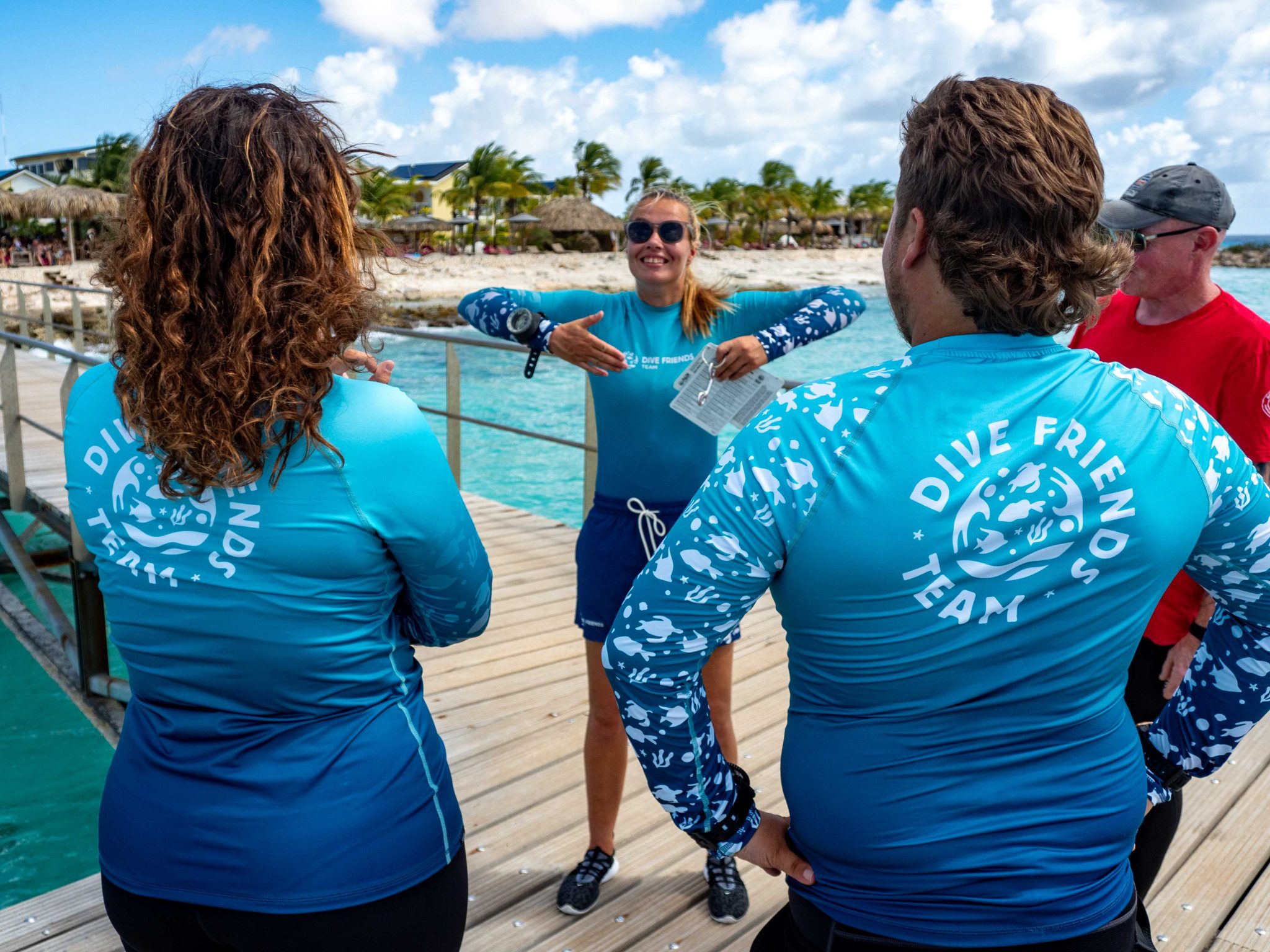
Dive Friends teaches the Instructor Development Course (IDC) several times a year to students who are eager to share their passion for diving with the world.
Dive Friends is known for the personal approach throughout the course. Their in-house course director will lead the students through every essential step, mentoring them to achieve their fullest potential as a dive instructor.
Applications for the following IDC start dates are now open:
- 12 April
- 5 July,
- 20 September
- 29 November
Partnership with Casita Palma
If the student opts for the IDC-Deluxe or IDC-Supreme package, their accommodation will be arranged for them at Casita Palma. This small and quiet resort is within walking distance from Dive Friends Bonaire’s main dive shop location and has everything you need to relax after an intense day of IDC training. Breakfast is included, so the student will always be fuelled and ready for their day.
Contact Dive Friends Bonaire’s Course Director Eddy for more information: coursedirector@divefriendsbonaire.com.
-

 News3 months ago
News3 months agoHone your underwater photography skills with Alphamarine Photography at Red Sea Diving Safari in March
-

 News3 months ago
News3 months agoCapturing Critters in Lembeh Underwater Photography Workshop 2024: Event Roundup
-

 Marine Life & Conservation Blogs2 months ago
Marine Life & Conservation Blogs2 months agoCreature Feature: Swell Sharks
-

 Blogs2 months ago
Blogs2 months agoMurex Resorts: Passport to Paradise!
-

 Blogs2 months ago
Blogs2 months agoDiver Discovering Whale Skeletons Beneath Ice Judged World’s Best Underwater Photograph
-

 Gear Reviews3 months ago
Gear Reviews3 months agoGear Review: Oceanic+ Dive Housing for iPhone
-

 Marine Life & Conservation2 months ago
Marine Life & Conservation2 months agoSave the Manatee Club launches brand new webcams at Silver Springs State Park, Florida
-

 News3 months ago
News3 months agoWorld’s Best Underwater Photographers Unveil Breathtaking Images at World Shootout 2023















